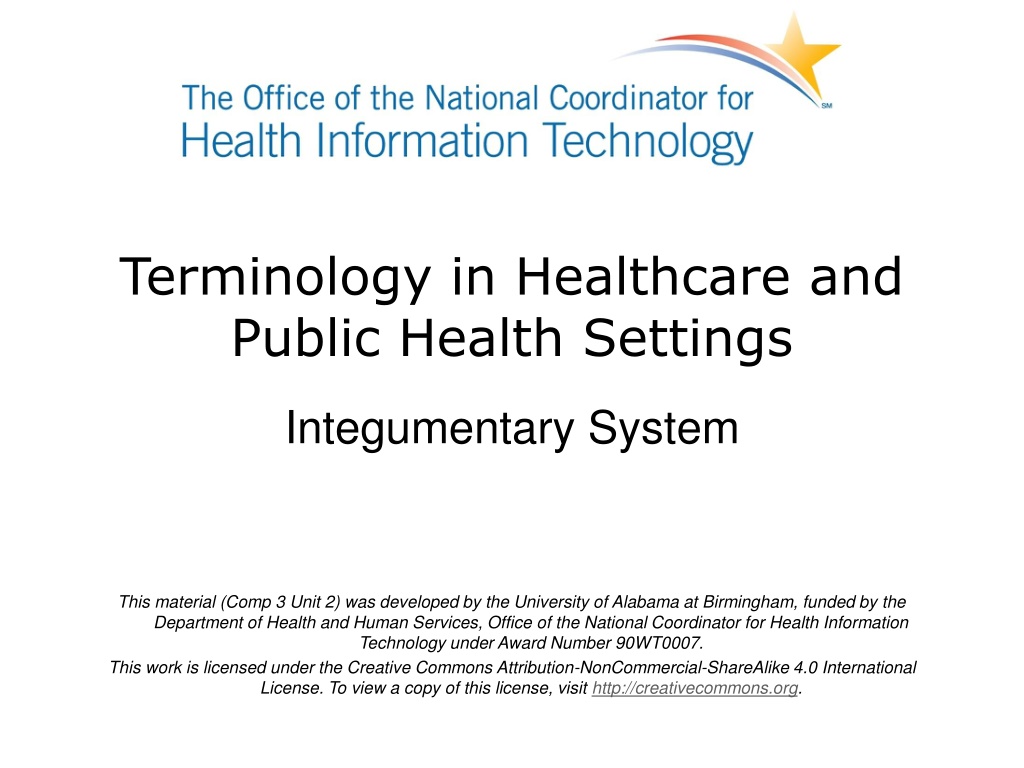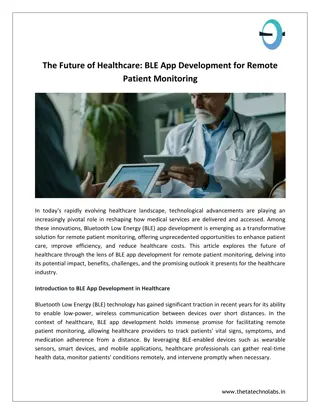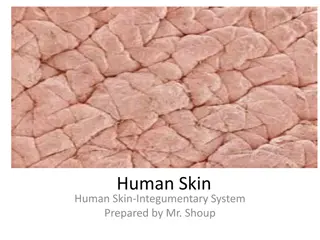Understanding the Integumentary System in Healthcare
Explore the integumentary system, which includes the skin, hair, nails, sebaceous glands, and sweat glands. Learn about its structure, functions, accessory organs, burns, skin cancer, and more. Enhance your knowledge of medical terms and common conditions related to the integumentary system.
Download Presentation

Please find below an Image/Link to download the presentation.
The content on the website is provided AS IS for your information and personal use only. It may not be sold, licensed, or shared on other websites without obtaining consent from the author. Download presentation by click this link. If you encounter any issues during the download, it is possible that the publisher has removed the file from their server.
E N D
Presentation Transcript
Terminology in Healthcare and Public Health Settings Integumentary System This material (Comp 3 Unit 2) was developed by the University of Alabama at Birmingham, funded by the Department of Health and Human Services, Office of the National Coordinator for Health Information Technology under Award Number 90WT0007. This work is licensed under the Creative Commons Attribution-NonCommercial-ShareAlike 4.0 International License. To view a copy of this license, visit http://creativecommons.org.
Integumentary System Learning Objectives Objectives Define, understand and correctly pronounce medical terms related to the integumentary system Describe common diseases and conditions with an overview of various treatments related to the integumentary system 2
Integumentary System Overview Organs of the integumentary system Skin Hair Nails Sebaceous glands Sweat glands Source: (MedlinePlus, 2011) 3
Integumentary System Overview 2 Covers the entire surface of the body Functions Protects against infection Houses nerve receptors Secretes fluids Regulates temperature 4
The Skin Three layers Epidermis thin, outer membrane layer Dermis middle, fibrous connective tissue layer Subcutaneous layer inner most layer of fatty tissue (Don Blis, illustrator) 5
Accessory Organs Located within dermis Include: Hair Nails Sweat glands Sebaceous glands 6
Burns There are three types of burns: First-degree burns damage only the outer layer of skin Second-degree burns damage the outer layer and the layer underneath Third-degree burns damage or destroy the deepest layer of skin and tissues underneath 7
Skin Cancer Most common form of cancer in the US Common types o Basal cell cancer o Squamous cell cancer o Location Head, face, neck, hands and arms Melanoma o more dangerous o less common 8
Skin Cancer 2 Anyone can get skin cancer, but it is more common in people who Spend a lot of time in the sun Have been sunburned Have light-colored skin, hair and eyes Have a family member with skin cancer Are over age 50 9
Wounds Include cuts, scrapes, scratches and punctured skin Often occur as a result of: an accident or injury surgical incisions sutures stitches Minor wounds usually aren't serious, but even cuts and scrapes require care 10
Common Hair Problems Include hair loss, infections, and disorders causing itching and scaling Hair loss (alopecia) is a frequent concern for both men and women. Male pattern baldness o most common cause of hair loss in men o receding hair line o baldness on the top of the head Female pattern baldness o hair becomes thin over the entire scalp 11
Common Hair Problems 2 Infections of the scalp bacterial infection of hair follicles head lice infestation fungal infection of scalp or ringworm Itching and excessive flaking of the scalp dandruff psoriasis 12
Problems With Nails Clue to your overall health Healthy nails smooth consistent in color Specific types of nail discoloration and changes in growth rate can signal lung, heart, kidney and liver diseases diabetes and anemia 13
Integumentary System Combining Forms Key Word Forms Cry/o Cutane/o Derm/o Kerat/o Lip/o Py/o Meaning Cold Skin Skin Hard, horny Fat Pus Sample Term Cryosurgery Cutaneous Dermatitis Keratosis Liposuction pyogenic 14
Tell me, Detective . . . Jane is seen in the ER with skin on her arm that is red, swollen, painful, and blanches when touched. The skin has also developed oozing blisters. This is indicative of First-degree burns Second-degree burns Third-degree burns 15
Integumentary System Summary Define, understand and correctly pronounce various medical terms related to the integumentary system Describe common diseases and conditions with an overview of various treatments related to the integumentary system 16
Integumentary System References References MedlinePlus [Internet]. Skin, hair and nails. Bethesda (MD): National Library of Medicine (US); [updated 2011 Jul 27]. Available from: www.nlm.nih.gov/medlineplus Images Slide 3: Available From: www.nlm.nih.gov/medlineplus Slide 5: Don Blis, illustrator. Available From: commons.wikimedia.org Slide 7: Available From: en.wikipedia.org Slide 7: Available From: en.wikipedia.org Slide 7: Craig0927. Available From: en.wikipedia.org Slide 8,9: Available From: www.cancer.gov Slide 15: Clip Art, Available from: Microsoft clips online; Used with permission from Microsoft 17
Terminology in Healthcare and Public Health Settings Integumentary System This material was developed by the University of Alabama at Birmingham, funded by the Department of Health and Human Services, Office of the National Coordinator for Health Information Technology under Award Number 90WT0007. 18























